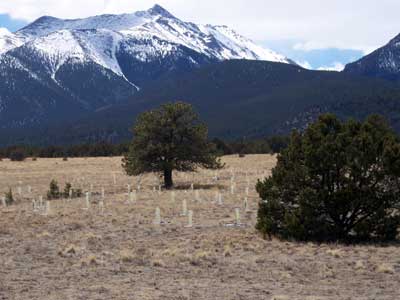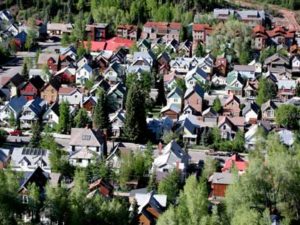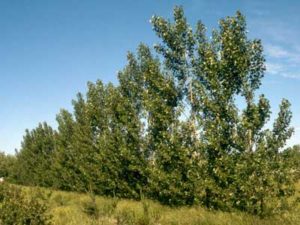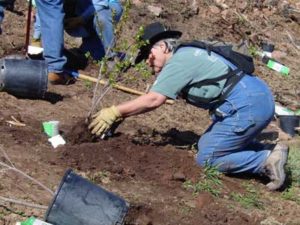Planting Trees for Conservation
Trees can be planted for several conservation purposes. These include windbreaks and living snow fences, wildlife habitat and forest restoration.
Conservation Plantings: Planning, Design and Site Preparation
Planting trees for conservation can provide many benefits. However, successful plantings require well-defined objectives that help answer many questions.
- Where are the trees planted?
- What are the prevailing or troublesome wind directions?
- What about drifting snow, water and power lines?
When planning a tree planting, whether in the mountains or on the plains or whether it is designed to control wind or snow, or benefit wildlife consider these factors:
- Location
- Elevation, slope and aspect
- Soil type and alkalinity
- Prevailing wind direction(s)
- Weed control methods
- Supplemental irrigation
- Snow drifting
- Power lines
- Planting size and shape
- Species selection
- Site preparation methods
- Underground utility locations
- Past land uses
Tree plantings benefit land and people by:
- Protecting property and livestock from wind
- Restoring or enhancing natural beauty
- Reducing soil erosion and improving crop yields

- Providing food and cover for wildlife
- Increasing property values
- Improving forest health
- Reducing water evaporation, preserving winter moisture, and protecting and improving water quality
- Controlling drifting snow
- Reducing atmospheric carbon dioxide
- Reducing heating and cooling costs (by providing protection from the sun and wind, trees can reduce energy costs by as much as 30 percent)
- Protecting livestock from the elements, maintaining and improving livestock weight, and reducing calving losses
- Increasing our supply of renewable resources
Site preparation enhances the soil’s ability to catch and store moisture, reduces grass and weed competition, and prepares the soil for planting.
- Medium to heavy (clay) soils can be summer-fallowed the year prior to planting. Leave it rough over the winter and disk, harrow or roto-till just before planting.
- Do not summer-fallow light, sandy soils, as they are subject to wind erosion. Instead, plant cover crops such as sorghum, grain or sudan grass the summer prior to tree planting. Cultivate just before planting, leaving the strip between rows uncultivated.
- Weeds and grasses take much-needed moisture away from newly planted seedlings. Eradicate weeds such as Canada thistle and bindweed before trees are planted; grasses should also be eliminated.

- Because wind eddies form around the ends of a windbreak, the planting should extend 100 feet beyond the area to be protected.
- Windbreak rows should be perpendicular to the prevailing winds.
- Do not plant trees closer than 100 feet to roads, driveways, buildings or other areas being protected. Snow drifts and blind corners created in these areas can be hazardous.
- For effective wind protection, plant at least three tree rows. The greater the density of the trees, the greater reduction in wind velocity.
Many people establish conservation plantings to attract wildlife. Each wildlife species has its own habitat requirements. Individual species can be attracted by planting trees and shrubs that provide food and cover.
To increase wildlife habitat, first decide which wildlife species is desired:
- To attract deer and elk, plant tree and shrub species that provide them with a winter source of food and cover. Big game animals seek feeding areas away from humans and roadways.
- If song birds are preferred, select species that are less desirable to deer and elk or the planting will be destroyed by excessive browsing.
 Mountain valley and forest plantings have unique requirements. Species selection is dependent on elevation and slope aspect.
Mountain valley and forest plantings have unique requirements. Species selection is dependent on elevation and slope aspect.
Planting within an existing forest (or where a forest once existed) is called reforestation. Reforestation can:
- Increase wildlife habitat
- Provide for future forest production
- Diversify forest species composition
- Replace trees lost to insects, diseases or fire
Many reforestation projects involve minimal site preparation and tree maintenance, and may involve planting large numbers of trees per acre due to expected mortality.
Generally, irrigation is not used to supplement natural moisture, but use of mulch is effective.
These publications offer more information on planning, designing and preparing sites for planting; designing windbreaks; and planting to promote wildlife.


